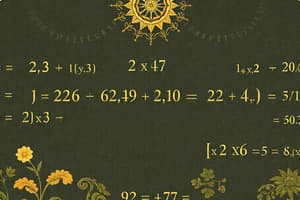Podcast
Questions and Answers
A sequence is defined by $a_n = 3n^2 - n$. What is the difference between the 5th and 3rd terms of this sequence?
A sequence is defined by $a_n = 3n^2 - n$. What is the difference between the 5th and 3rd terms of this sequence?
- 36
- 24
- 60
- 42 (correct)
Which of the following equations represents a line that is parallel to $2x + 3y = 6$ and passes through the point (3, -2)?
Which of the following equations represents a line that is parallel to $2x + 3y = 6$ and passes through the point (3, -2)?
- $3x + 2y = 13$
- $2x + 3y = 0$ (correct)
- $3x - 2y = 5$
- $2x + 3y = 12$
In an arithmetic sequence, the 7th term is 23 and the 12th term is 48. What is the common difference of this sequence?
In an arithmetic sequence, the 7th term is 23 and the 12th term is 48. What is the common difference of this sequence?
- 10
- 3
- 8
- 5 (correct)
Consider the geometric sequence where the second term is 6 and the fifth term is 162. What is the first term of the sequence?
Consider the geometric sequence where the second term is 6 and the fifth term is 162. What is the first term of the sequence?
What is the solution to the system of linear equations: $3x + 2y = 7$ and $x - y = -1$?
What is the solution to the system of linear equations: $3x + 2y = 7$ and $x - y = -1$?
A taxi service charges an initial fee of $2.50 plus $0.4 per tenth of a mile. Write a linear equation representing the total cost, and find out the total cost for a 5 mile journey. Note: 1 tenth of a mile = 0.1 mile.
A taxi service charges an initial fee of $2.50 plus $0.4 per tenth of a mile. Write a linear equation representing the total cost, and find out the total cost for a 5 mile journey. Note: 1 tenth of a mile = 0.1 mile.
A person invests $1000 in an account that earns 5% interest annually. If the interest is added to the account each year, which type of sequence best models the account balance each year?
A person invests $1000 in an account that earns 5% interest annually. If the interest is added to the account each year, which type of sequence best models the account balance each year?
Given two points, (2, -3) and (5, 3), what is the equation of the line passing through these points in slope-intercept form?
Given two points, (2, -3) and (5, 3), what is the equation of the line passing through these points in slope-intercept form?
In a certain Fibonacci-like sequence, the first term is 1 and the second term is 3. Each subsequent term is the sum of all preceding terms. What is the 5th term of this sequence?
In a certain Fibonacci-like sequence, the first term is 1 and the second term is 3. Each subsequent term is the sum of all preceding terms. What is the 5th term of this sequence?
A store is having a sale where all items normally priced at $x$ dollars are discounted by 15%. If a customer buys three items during this sale, what will be their expression for total cost?
A store is having a sale where all items normally priced at $x$ dollars are discounted by 15%. If a customer buys three items during this sale, what will be their expression for total cost?
Flashcards
Sequence
Sequence
An ordered list of numbers where each number is called a term.
Arithmetic Sequence
Arithmetic Sequence
A sequence where the difference between consecutive terms is constant.
Geometric Sequence
Geometric Sequence
A sequence where the ratio between consecutive terms is constant.
Fibonacci Sequence
Fibonacci Sequence
Signup and view all the flashcards
Linear Equation
Linear Equation
Signup and view all the flashcards
Slope
Slope
Signup and view all the flashcards
Y-Intercept
Y-Intercept
Signup and view all the flashcards
Solving Linear Equations
Solving Linear Equations
Signup and view all the flashcards
System of Linear Equations
System of Linear Equations
Signup and view all the flashcards
Substitution Method
Substitution Method
Signup and view all the flashcards
Study Notes
Sequences
- A sequence is an ordered list of numbers.
- Each number in the sequence is called a term.
- Sequences can be finite (ending) or infinite (continuing).
- Sequences can be described by a rule or formula.
Types of Sequences
- Arithmetic sequences:
- The difference between consecutive terms is constant.
- The nth term can be found using the formula: an = a1 + (n-1)d, where a1 is the first term, n is the term number, and d is the common difference.
- Geometric sequences:
- The ratio between consecutive terms is constant.
- The nth term can be found using the formula: an = a1 * r(n-1), where a1 is the first term, n is the term number, and r is the common ratio.
- Other sequences:
- Fibonacci sequence: Each term is the sum of the two preceding terms.
- Other sequences are defined by more complex rules.
Linear Equations
- A linear equation is an equation that can be written in the form ax + b = 0, where a and b are constants and x is the variable.
- The graph of a linear equation is a straight line.
- The slope of the line represents the rate of change.
- The y-intercept is the point where the line crosses the y-axis.
- Standard form of a linear equation is Ax + By = C
- Slope-intercept form of a linear equation is y = mx + b, where:
- m is the slope
- b is the y-intercept
Solving Linear Equations
- To solve a linear equation, isolate the variable.
- This involves performing the same operation on both sides of the equation to maintain equality.
- Example: To solve 2x + 5 = 11, subtract 5 from both sides to get 2x = 6, then divide both sides by 2 to get x = 3.
Systems of Linear Equations
- A system of linear equations consists of two or more linear equations.
- A solution to the system is a set of values for the variables that satisfy all the equations in the system.
- Methods for solving systems of linear equations include:
- Substitution: Solve one equation for one variable and substitute that expression into the other equation.
- Elimination: Add or subtract multiples of the equations to eliminate a variable.
- Graphing: Graph both equations and find the point of intersection.
Applications of Linear Equations and Sequences
- Modeling real-world scenarios:
- Calculating costs (e.g., total cost = fixed cost + variable cost)
- Analyzing growth rates (e.g., population growth, investments).
- Determining formulas for relationships between variables.
- Finding unknown values in a problem scenario.
- Calculating future values.
Key Relationships Between Linear Equations and Sequences
- Often, sequences are described by linear equations.
- Arithmetic sequences can be represented by linear equations.
- The general form of a linear equation with a sequence in it, y = mx + b, can be applied to the nth term of the sequence.
Connecting Linear Equations and Sequences:
- The nth term of an arithmetic sequence can be expressed as a linear equation.
- The linear equation's slope corresponds to the common difference in the sequence, and the y-intercept relates to the first term.
- Geometric sequences can be represented by equations with exponents, typically not linear.
Studying That Suits You
Use AI to generate personalized quizzes and flashcards to suit your learning preferences.




